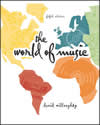Chapter 9 Music Beyond the Americas Musical traditions of India, Japan,
Sub-Saharan Africa, and other world cultures A discussion of the philosophy underlying this chapter was presented in the commentary introducing Part III, "Listening to World Music." The aesthetic nature of the music of India is considered. Discussion is limited to Hindustani music from northern India, although many of the characteristics apply to the music of all of India. Japanese music history and musical styles are compared and contrasted with those of Western culture. The place of traditional Japanese music in contemporary Japanese society is examined, particularly in relation to the place of Western music in that society. In sub-Saharan African music, the importance of an enormous variety of musical instruments, particularly percussion instruments of every size and shape, is discussed. Functional music and community participation are important aspects of the culture. One sees in contemporary African culture, including its popular music, the blending of traditional values and practices with those derived from Western influences. This rich cultural heritage of European music, especially from Russia and Eastern Europe, has produced a great diversity of musical styles that, through the ethnic music of immigrants from this region, has immensely benefited music in American culture. The relationship of immigrant music to American culture is discussed. The chapter notes the tendency of the Jewish people through many years without a homeland to balance ethnic preservation and assimilation. It notes the significant contributions of Jewish immigrants to American music, particularly their ability to capture the American spirit in their songs and orchestral pieces. The chapter explores musical characteristics that contribute to the essential character of Jewish music. Finally, we take a brief look at the traditional gamelan music of Indonesia as well as its vibrant popular music. Goals for Listening - Recognize melodic embellishments
- Identify ostinato patterns
- Identify call and response
| 


 2003 McGraw-Hill Higher Education
2003 McGraw-Hill Higher Education